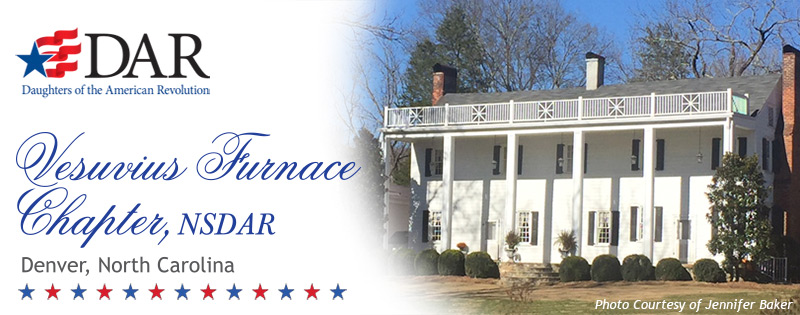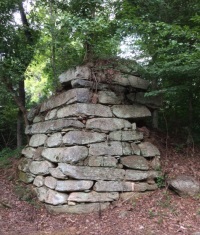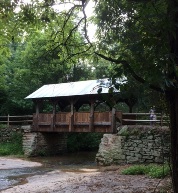
History of Vesuvius Furnace
The home known as Vesuvius is the oldest standing home in Lincoln County located between Denver and Iron Station. At one time, the plantation was a majority of what is now Lincoln County. Built in 1792 by General Joseph Graham, Vesuvius has seen over 200 years of American history. Located on the property are the remnants of the iron furnace built by Graham in 1790. This was one of the first of many furnaces built in Lincoln County that helped to produce many different types of iron works well into the 1800s. Joseph Graham and his family played a big role in North Carolina politics and industry. Most notably, his son William Graham served as governor of North Carolina, Secretary of the Navy, and was a vice president candidate. The home was placed on the National Register of Historic Places in 1974 as the home place of General Joseph Graham and still maintains most of its original structure and architecture.

Furnace Remains
Photo Courtesy Beverly Robinson
The house was built in two sections: the older dated to about 1792, with the western section added about 1810-1820. It is a two-story, five bays wide and two deep, frame structure with a one-story shed porch. The furnace was built in 1790, and is constructed of large stone blocks of random sizes, but about half of the square pyramidal structure has fallen down. The furnace remains are about 20 feet high and filled with dirt, debris, and vegetation.
After the war, Alexander Brevard married Rebecca Davidson, the daughter of Major John Davidson of Mecklenburg County, a practical blacksmith, opponent of British authority, planter, and ironmonger. In about 1792, John Davidson, Alexander Brevard, and Joseph Graham, entered partnership with Peter Forney, a pioneer in the Lincoln County iron industry; they purchased a share in the "big ore bank", a few miles east of Lincolnton, and made plans to erect facilities to manufacture iron products. Brevard moved his family to Lincoln County and settled on Leeper's Creek, where he built Mt. Tirza Forge; on adjoining land, Graham built Vesuvius Furnace. In 1795, Forney sold his interest in the partnership, and the others continued to operate under the name Joseph Graham and Company, with Davidson leaving actual management to his sons-in-law. The business proved highly lucrative, and additional land was acquired. By 1804, when Davidson sold his interest to Brevard and Graham, the company assets included over five thousand acres; nine slaves; improvements, equipment, and stock valued conservatively at $5,000; and cash and notes receivable in the amount of $8,876. Brevard and Graham continued the partnership as Brevard and Company until 1814, when the business relationship was dissolved.
Joseph Graham was not only the founder of Vesuvius Furnace, he was a Major in the Revolutionary War, and a Major-General in the War of 1812. He voted "yea" when North Carolina ratified the United States Constitution in Fayetteville in 1789. Many of his descendants live in this area today. Isabella Davidson was the wife of General Graham and her father was a Signer of the Mecklenburg Declaration of Independence. Captain Alexander Brevard was a landowner and Mary Brevard was the wife of General Davidson who was killed at the Battle of Cowan's Ford. Peter Forney was the son of Jacob Forney for whom the Jacob Forney Chapter NSDAR is named. Peter Forney and his brothers, Jacob and Abram, all saw military service during the American Revolution. His parents were Swiss immigrants who also firmly supported the American cause and are also proven patriots by the DAR.
The name "Vesuvius" was allegedly given to it since the iron furnace smoked like Mount Vesuvius, which experienced relatively severe eruptions almost continuously from 1631 to 1944. In addition to wood from what was likely hundreds of acres of nearby trees every year, Graham's blast furnace may have also been fueled by limestone and iron ore from the kiln and mine at the farmstead of Casper Kühner. Jacob, son of Abraham Kühner and grandson of Casper Kühner, granted the historic Keener Farmstead to Lawson Keener in 1853. In addition to documenting Abraham's actions at the Battle of Ramsour's Mill, Joseph Graham also served on a committee to settle his estate in 1799. Joseph Graham is buried near his historic homeplace in Machpelah Presbyterian Church Cemetery. Alexander Brevard is also buried there as well as many members of the Graham, Davidson, Forney and Brevard families.
The home was acquired by the Lineberger family in 1945 and is listed on the National Register of Historic Places. In 2009, it was privately restored and opened as Vesuvius Vineyards, a wine vineyard and wedding venue. Much of the original architecture is still intact including the outside kitchen and separate kitchen building behind the home.
The content contained herein does not necessarily represent the position of the NSDAR. Web hyperlinks to
non-DAR sites are not the responsibility of the NSDAR, the state organizations, or individual DAR chapters.
